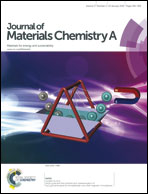A rational construction of microporous imide-bridged covalent–organic polytriazines for high-enthalpy small gas absorption†
Abstract
A series of microporous imide functionalized 1,3,5-triazine frameworks (named TPIs@IC) were designed by an easy-construction technology other than the known imidization method for the construction of porous triazine-based polyimide networks (TPIs) with the same chemical compositions. In contrast to TPIs, TPIs@IC exhibit much higher Brunauer–Emmett–Teller (BET) surface areas (up to 1053 m2 g−1) and carbon dioxide uptake (up to 3.2 mmol g−1/14.2 wt% at 273 K/1 bar). The presence of abundant ultramicropores at 5.4–6.8 Å, mainly ascribed to a high-level cyano cross-linking, allows the high heat absorption and high selective capture of CO2. The Qst (CO2 esoteric enthalpies) from their CO2 adsorption isotherms at 273 and 298 K are calculated to be in the range 46.1–49.3 kJ mol−1 at low CO2 loading, and the ideal CO2/N2 separation factors are up to 151, exceeding those of the most reported porous organic polymers to date. High storage capacities of TPIs@IC for other small gases like CH4 (5.01 wt% at 298 K/22 bar) and H2 (1.47 wt% at 77 K/1 bar) were also observed, making them promising adsorbents for gas adsorption and separation.


 Please wait while we load your content...
Please wait while we load your content...